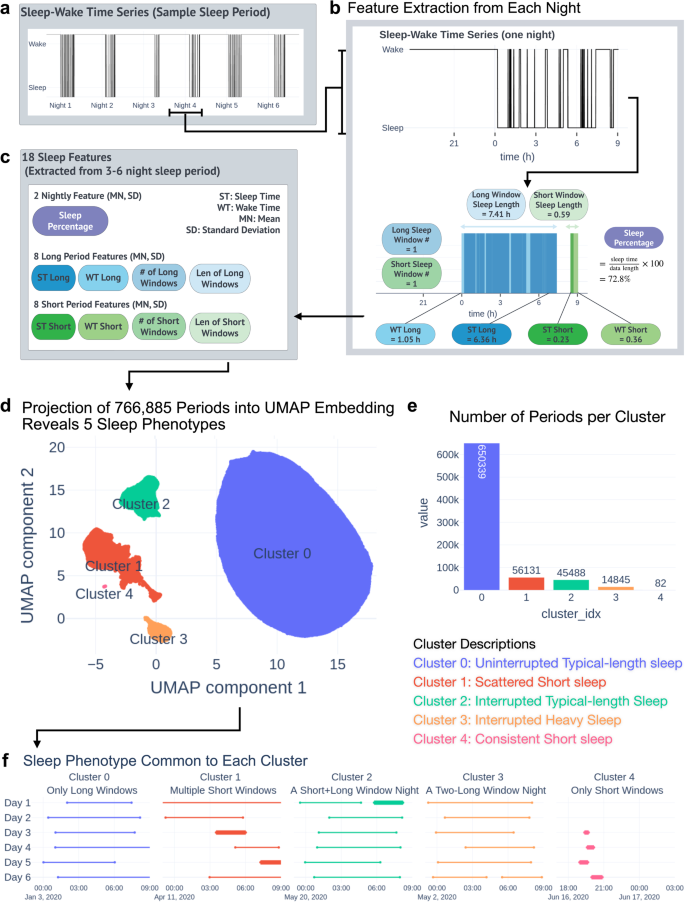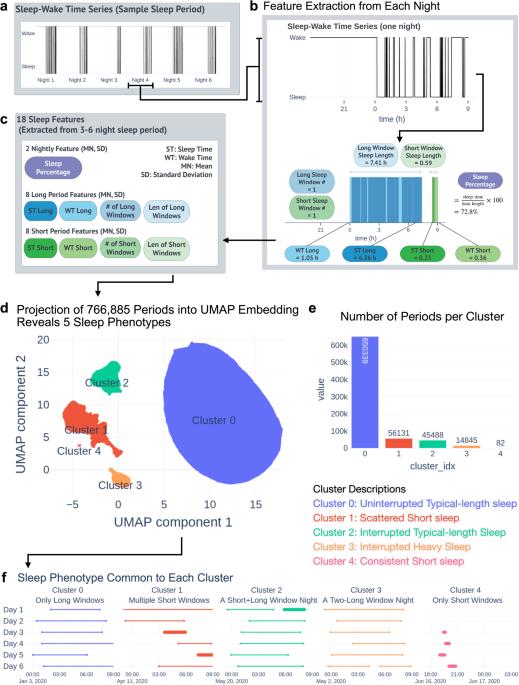五百万个夜晚:人类睡眠表型的时间动态变化
IF 12.4
1区 医学
Q1 HEALTH CARE SCIENCES & SERVICES
引用次数: 0
摘要
随着经济实惠的可穿戴设备的兴起,睡眠监测变得越来越普遍。然而,将睡眠数据转化为可操作的变化仍具有挑战性,因为各种因素会导致睡眠参数组合随时间推移而在人与人之间以及人与人之间产生差异。研究人员尝试将睡眠参数组合在一起,以更好地检测不同夜晚睡眠的相似性。一晚睡眠中相似的睡眠参数组合群定义了当晚的睡眠表型。迄今为止,根据从大量人群中收集到的数据建立的睡眠表型定量模型都使用了横断面数据,这就排除了纵向分析,而纵向分析可以更好地量化个体内部随时间变化而产生的差异。在本文报告的分析中,我们使用了五百万夜的可穿戴睡眠数据来测试:(a)个体的睡眠表型是否会随着时间的推移而发生变化;(b)这些变化是否阐明了急性疾病(如流感、发烧、COVID-19)的新信息。我们发现了与睡眠质量相关的 13 种睡眠表型的证据,而且个体会随着时间的推移在这些表型之间转换。过渡模式在以下两个方面存在明显差异:(i) 不同个体之间(有慢性疾病与无慢性疾病;Chi-square 检验;p-value < 1e-100);(ii) 不同个体内部随时间变化(急性病前与急性病期间;Chi-Square 检验;p-value < 1e-100)。最后,我们发现,与单独的表型成员资格相比,过渡模式包含了更多有关慢性和急性健康状况的信息(纵向分析产生的信息量是横截面分析的 2-10 倍)。这些结果支持在未来的纵向睡眠分析中使用时间动态分析。本文章由计算机程序翻译,如有差异,请以英文原文为准。


Five million nights: temporal dynamics in human sleep phenotypes
Sleep monitoring has become widespread with the rise of affordable wearable devices. However, converting sleep data into actionable change remains challenging as diverse factors can cause combinations of sleep parameters to differ both between people and within people over time. Researchers have attempted to combine sleep parameters to improve detecting similarities between nights of sleep. The cluster of similar combinations of sleep parameters from a night of sleep defines that night’s sleep phenotype. To date, quantitative models of sleep phenotype made from data collected from large populations have used cross-sectional data, which preclude longitudinal analyses that could better quantify differences within individuals over time. In analyses reported here, we used five million nights of wearable sleep data to test (a) whether an individual’s sleep phenotype changes over time and (b) whether these changes elucidate new information about acute periods of illness (e.g., flu, fever, COVID-19). We found evidence for 13 sleep phenotypes associated with sleep quality and that individuals transition between these phenotypes over time. Patterns of transitions significantly differ (i) between individuals (with vs. without a chronic health condition; chi-square test; p-value < 1e−100) and (ii) within individuals over time (before vs. during an acute condition; Chi-Square test; p-value < 1e−100). Finally, we found that the patterns of transitions carried more information about chronic and acute health conditions than did phenotype membership alone (longitudinal analyses yielded 2–10× as much information as cross-sectional analyses). These results support the use of temporal dynamics in the future development of longitudinal sleep analyses.
求助全文
通过发布文献求助,成功后即可免费获取论文全文。
去求助
来源期刊

NPJ Digital Medicine
Multiple-
CiteScore
25.10
自引率
3.30%
发文量
170
审稿时长
15 weeks
期刊介绍:
npj Digital Medicine is an online open-access journal that focuses on publishing peer-reviewed research in the field of digital medicine. The journal covers various aspects of digital medicine, including the application and implementation of digital and mobile technologies in clinical settings, virtual healthcare, and the use of artificial intelligence and informatics.
The primary goal of the journal is to support innovation and the advancement of healthcare through the integration of new digital and mobile technologies. When determining if a manuscript is suitable for publication, the journal considers four important criteria: novelty, clinical relevance, scientific rigor, and digital innovation.
 求助内容:
求助内容: 应助结果提醒方式:
应助结果提醒方式:


